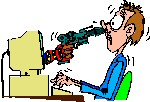Terminations – How to Let Your People Go
Terminating employees is never easy. You need to understand the “why” and “how” of this, as well as how fast you should act in different situations.
Why Terminate an Employee?
There are basically three reasons why you find yourself firing employees:
 They have committed a criminal act against your organisation.
They have committed a criminal act against your organisation.- Their results are consistently poor.
- Your need to reduce staff because of external economic conditions.
The other circumstance involving the loss of an employee is, of course, when they resign.
Performance Firing
Before you fire someone who is not performing well, it would be the right thing to do to see if there is some other job they can perform.
Sometimes you have a square peg in a round hole. Maybe they have talents in another area altogether.
How Fast Should You Let Them Go?
- If the employee dismissal is for criminal activity or poor performance, the termination should be immediate. There are a couple of exceptions to this, however. See Employee Dismissal: Immediate or Delayed? for details.
- If they are a good performer and they are resigning (leaving your organisation), see if you can get them to stay on for a reasonable time to train the replacement.
Downsizing
This is a special situation. External economic conditions dictate that you cannot continue to keep the number of people you currently have. To protect the future existence of your company, terminating employees is sometimes unavoidable.
There is a way to handle this situation so that such that the downsizing does not demotivate your remaining staff. If you don’t do this right, you may suffer an unnecessary reduction in your future production capability.
